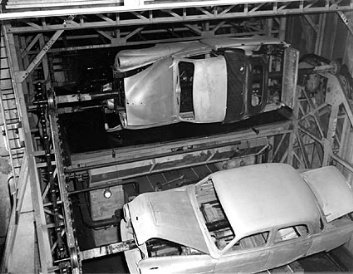THE ROTODIP PROCESS

Two Austin 1800's
on the "skewer".
Photo Courtesy National
Archives Australia - A1200 - L54594
BMC use a process called electro-coating to supplement their basic Rotodip rust proofing treatment.
The Rotodip method
treated and painted complete car bodies. The electro-coating plant was
used to paint small components not able to be treated on the huge Rotodip
machine. The combined result provides complete rustproofing of all painted
components of BMC cars.
The electro-coating
installation cost $280,000 and was the first of its kind in Australia. It was in operation
since May 1966.
Electro-coating is
a similar process to electroplating. Metal is plated, rather than sprayed,
with paint to give uniform and complete coverage, even inside tubes
and other normally inaccessible areas.
Bodies for all Australian
made BMC's - Mini, Morris 1100 and Austin 1800 were all treated on the
$2 million Rotodip machine during manufacture. On this exclusive machine,
the unpainted bodyshell and doors were submerged and rotated in a series
of baths containing phosphates and primer. This treated and covered
every metal surface, both inside and out, to prevent the onset of rust.
The electro-coating
plant painted small parts, which could not be treated by the Rotodip
process. This included such parts as the fascia, or dashboard panel,
heater boxes, grille panels and numerous small sheet metal parts not
welded to the body itself.
Electro-coating was
a major advance in the technology of metal coating. It involved a dip
process in which paint is held in suspension by a liquid. The paint
is deposited on the metal component when an electric current passes
from an electrode to the vehicle, which acts as the other electrode.
Paint particles are attracted to the metal, coagulate and are deposited
until an even paint film covers the entire surface, including edges
and remote crevices, and all internal surfaces. When the paint film
reached a certain thickness it insulated the metal and prevented more
paint being deposited.
When deposited, the
paint is hard and cannot be removed.
Unlike spraying or
conventional non-handling dipping methods, electro-coating left no uncoated
areas in parts of complicated shapes. It also gave an even paint thickness
and virtually eliminated paint loss.
The Rotodip process
fully immersed and rotates each sedan body in a six-stage phosphating
machine, then took it through a drying-off oven, followed by a dip tank
of special rust inhibiting priming paint, and a primer baking oven.
All these processes were continuous and automatic.
To move through the
machine the unpainted car body was skewered on a long metal spit, which
had a sprocket at one end. The sprocket ran on a toothed rack, so that
the spit - and the body clamped to it - rotated as they moved.
The first tank contained
a heated alkali to remove oil and other contaminants. The second tank
contained a cold water rinse, and the third a hot water rinse, to make
sure the body was perfectly clean before it enterd the phosphating tank.
In the phosphating
section the 'skewered' body was lowered into various tanks while rotating.
At the same time high pressure jets sprayed the solution so that every
bare metal portion of the body was treated, both inside and out. Phosphating
is actually a conversion of the body steel surface so that if the paint
surface was damaged accidentally during use, corrosion would not spread.
It also acted as a bond between steel and paint.
The phosphating was
followed by a hot water rinse and then by a heated chromic acid rinse.
The body completed two slow revolutions in each tank. After phosphating,
the body was dried in an oven. It was then dipped and rotated in a 7,000
gallon tank of primer, remaining for 2.6 minutes. This meant that every
particle of bare metal received a coating of paint. Excess paint drained
away through special holes provided in body panels and other enclosed
parts. The painted body, still rotating, was baked in an oven for 30
minutes at 340 degrees Farenheit.